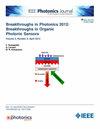Silicon-Organic Hybrid Modulators Based on a Coupled One-Dimensional Photonic Crystal Slot Resonator Waveguide
IF 2.4
4区 工程技术
Q3 ENGINEERING, ELECTRICAL & ELECTRONIC
引用次数: 0
Abstract
High-speed and energy-efficient optical interconnects critically rely on electro-optical (EO) modulators, whose performance metrics struggle to meet the exponentially increasing demands of the near future. Silicon-organic hybrid (SOH) modulators present a promising solution due to the favorable electro-optic coefficients and fast response times of EO organic materials. However, the waveguide's nature limits the effective interaction between photons and EO materials. Although this interaction can be enhanced by utilizing advanced structures such as slot waveguides and slow-light techniques, new challenges arise, including strong dispersion that compromises bandwidth. In this paper, we propose a novel low-dispersion, slow-light waveguide structure based on a coupled one-dimensional photonic crystal slot resonator waveguide (coupled 1D PC SROW). By cascading multiple coupled resonators, the structure creates a low-dispersion, slow-light region within the photonic bandgap. Combining the strong optical field confinement of the slot with the slow-light enhancement in the time domain, modulation efficiency, quantified by基于耦合一维光子晶体槽谐振波导的硅-有机混合调制器
高速和节能的光互连严重依赖于电光(EO)调制器,其性能指标难以满足不久的将来指数级增长的需求。有机硅杂化(SOH)调制器由于其良好的电光系数和快速的响应时间而成为一种很有前途的解决方案。然而,波导的性质限制了光子与EO材料之间的有效相互作用。虽然这种相互作用可以通过利用先进的结构,如槽波导和慢光技术来增强,但新的挑战出现了,包括牺牲带宽的强色散。在本文中,我们提出了一种基于耦合一维光子晶体槽腔波导(耦合1D PC SROW)的新型低色散慢光波导结构。通过级联多个耦合谐振器,该结构在光子带隙内产生低色散、慢光区域。将狭缝的强光场约束与慢光在时域的增强相结合,可以显著提高用VπL量化的调制效率。作为一个例子,我们证明了在2.55 nm的低色散波长范围内,VπL可以达到0.57 Vmm。调制效率的提高允许将移相器长度减少到119 μm,克服了电波和光波之间的空间漂移所带来的带宽限制,实现了108 GHz的带宽,这对传统方法来说是一个挑战。这项研究提出了一种可行的替代方案来实现紧凑、超宽带和节能的光调制器。
本文章由计算机程序翻译,如有差异,请以英文原文为准。
求助全文
约1分钟内获得全文
求助全文
来源期刊

IEEE Photonics Journal
ENGINEERING, ELECTRICAL & ELECTRONIC-OPTICS
CiteScore
4.50
自引率
8.30%
发文量
489
审稿时长
1.4 months
期刊介绍:
Breakthroughs in the generation of light and in its control and utilization have given rise to the field of Photonics, a rapidly expanding area of science and technology with major technological and economic impact. Photonics integrates quantum electronics and optics to accelerate progress in the generation of novel photon sources and in their utilization in emerging applications at the micro and nano scales spanning from the far-infrared/THz to the x-ray region of the electromagnetic spectrum. IEEE Photonics Journal is an online-only journal dedicated to the rapid disclosure of top-quality peer-reviewed research at the forefront of all areas of photonics. Contributions addressing issues ranging from fundamental understanding to emerging technologies and applications are within the scope of the Journal. The Journal includes topics in: Photon sources from far infrared to X-rays, Photonics materials and engineered photonic structures, Integrated optics and optoelectronic, Ultrafast, attosecond, high field and short wavelength photonics, Biophotonics, including DNA photonics, Nanophotonics, Magnetophotonics, Fundamentals of light propagation and interaction; nonlinear effects, Optical data storage, Fiber optics and optical communications devices, systems, and technologies, Micro Opto Electro Mechanical Systems (MOEMS), Microwave photonics, Optical Sensors.
 求助内容:
求助内容: 应助结果提醒方式:
应助结果提醒方式:


